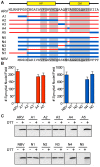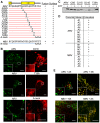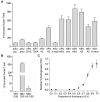A compact, multifunctional fusion module directs cholesterol-dependent homomultimerization and syncytiogenic efficiency of reovirus p10 FAST proteins
- PMID: 24651689
- PMCID: PMC3961370
- DOI: 10.1371/journal.ppat.1004023
A compact, multifunctional fusion module directs cholesterol-dependent homomultimerization and syncytiogenic efficiency of reovirus p10 FAST proteins
Abstract
The homologous p10 fusion-associated small transmembrane (FAST) proteins of the avian (ARV) and Nelson Bay (NBV) reoviruses are the smallest known viral membrane fusion proteins, and are virulence determinants of the fusogenic reoviruses. The small size of FAST proteins is incompatible with the paradigmatic membrane fusion pathway proposed for enveloped viral fusion proteins. Understanding how these diminutive viral fusogens mediate the complex process of membrane fusion is therefore of considerable interest, from both the pathogenesis and mechanism-of-action perspectives. Using chimeric ARV/NBV p10 constructs, the 36-40-residue ectodomain was identified as the major determinant of the differing fusion efficiencies of these homologous p10 proteins. Extensive mutagenic analysis determined the ectodomain comprises two distinct, essential functional motifs. Syncytiogenesis assays, thiol-specific surface biotinylation, and liposome lipid mixing assays identified an ∼25-residue, N-terminal motif that dictates formation of a cystine loop fusion peptide in both ARV and NBV p10. Surface immunofluorescence staining, FRET analysis and cholesterol depletion/repletion studies determined the cystine loop motif is connected through a two-residue linker to a 13-residue membrane-proximal ectodomain region (MPER). The MPER constitutes a second, independent motif governing reversible, cholesterol-dependent assembly of p10 multimers in the plasma membrane. Results further indicate that: (1) ARV and NBV homomultimers segregate to distinct, cholesterol-dependent microdomains in the plasma membrane; (2) p10 homomultimerization and cholesterol-dependent microdomain localization are co-dependent; and (3) the four juxtamembrane MPER residues present in the multimerization motif dictate species-specific microdomain association and homomultimerization. The p10 ectodomain therefore constitutes a remarkably compact, multifunctional fusion module that directs syncytiogenic efficiency and species-specific assembly of p10 homomultimers into cholesterol-dependent fusion platforms in the plasma membrane.
Conflict of interest statement
The authors have declared that no competing interests exist.
Figures








Similar articles
-
The p10 FAST protein fusion peptide functions as a cystine noose to induce cholesterol-dependent liposome fusion without liposome tubulation.Biochim Biophys Acta. 2015 Feb;1848(2):408-16. doi: 10.1016/j.bbamem.2014.10.020. Epub 2014 Oct 23. Biochim Biophys Acta. 2015. PMID: 25450808
-
Features of a spatially constrained cystine loop in the p10 FAST protein ectodomain define a new class of viral fusion peptides.J Biol Chem. 2010 May 28;285(22):16424-33. doi: 10.1074/jbc.M110.118232. Epub 2010 Apr 2. J Biol Chem. 2010. PMID: 20363742 Free PMC article.
-
Polycistronic Genome Segment Evolution and Gain and Loss of FAST Protein Function during Fusogenic Orthoreovirus Speciation.Viruses. 2020 Jun 29;12(7):702. doi: 10.3390/v12070702. Viruses. 2020. PMID: 32610593 Free PMC article.
-
Reovirus FAST proteins: virus-encoded cellular fusogens.Trends Microbiol. 2014 Dec;22(12):715-24. doi: 10.1016/j.tim.2014.08.005. Epub 2014 Sep 19. Trends Microbiol. 2014. PMID: 25245455 Review.
-
Fusogenic Reoviruses and Their Fusion-Associated Small Transmembrane (FAST) Proteins.Annu Rev Virol. 2019 Sep 29;6(1):341-363. doi: 10.1146/annurev-virology-092818-015523. Epub 2019 Jul 5. Annu Rev Virol. 2019. PMID: 31283438 Review.
Cited by
-
Cholesterol-Rich Lipid Rafts in the Cellular Membrane Play an Essential Role in Avian Reovirus Replication.Front Microbiol. 2020 Nov 2;11:597794. doi: 10.3389/fmicb.2020.597794. eCollection 2020. Front Microbiol. 2020. PMID: 33224131 Free PMC article.
-
Reovirus FAST Protein Enhances Vesicular Stomatitis Virus Oncolytic Virotherapy in Primary and Metastatic Tumor Models.Mol Ther Oncolytics. 2017 Aug 4;6:80-89. doi: 10.1016/j.omto.2017.08.001. eCollection 2017 Sep 15. Mol Ther Oncolytics. 2017. PMID: 28856238 Free PMC article.
-
A Bat-Derived Putative Cross-Family Recombinant Coronavirus with a Reovirus Gene.PLoS Pathog. 2016 Sep 27;12(9):e1005883. doi: 10.1371/journal.ppat.1005883. eCollection 2016 Sep. PLoS Pathog. 2016. PMID: 27676249 Free PMC article.
-
Whole-Genome Analysis of a Novel Fish Reovirus (MsReV) Discloses Aquareovirus Genomic Structure Relationship with Host in Saline Environments.Viruses. 2015 Aug 3;7(8):4282-302. doi: 10.3390/v7082820. Viruses. 2015. PMID: 26247954 Free PMC article.
-
How cells fuse.J Cell Biol. 2019 May 6;218(5):1436-1451. doi: 10.1083/jcb.201901017. Epub 2019 Apr 1. J Cell Biol. 2019. PMID: 30936162 Free PMC article. Review.
References
-
- Chua KB, Bellini WJ, Rota PA, Harcourt BH, Tamin A, et al. (2000) Nipah virus: a recently emergent deadly paramyxovirus. Science 288: 1432–1435. - PubMed
-
- Halpin K, Young PL, Field HE, Mackenzie JS (2000) Isolation of Hendra virus from pteropid bats: a natural reservoir of Hendra virus. J Gen Virol 81: 1927–1932. - PubMed
-
- Li W, Shi Z, Yu M, Ren W, Smith C, et al. (2005) Bats are natural reservoirs of SARS-like coronaviruses. Science 310: 676–679. - PubMed
Publication types
MeSH terms
Substances
Grants and funding
LinkOut - more resources
Full Text Sources
Other Literature Sources

